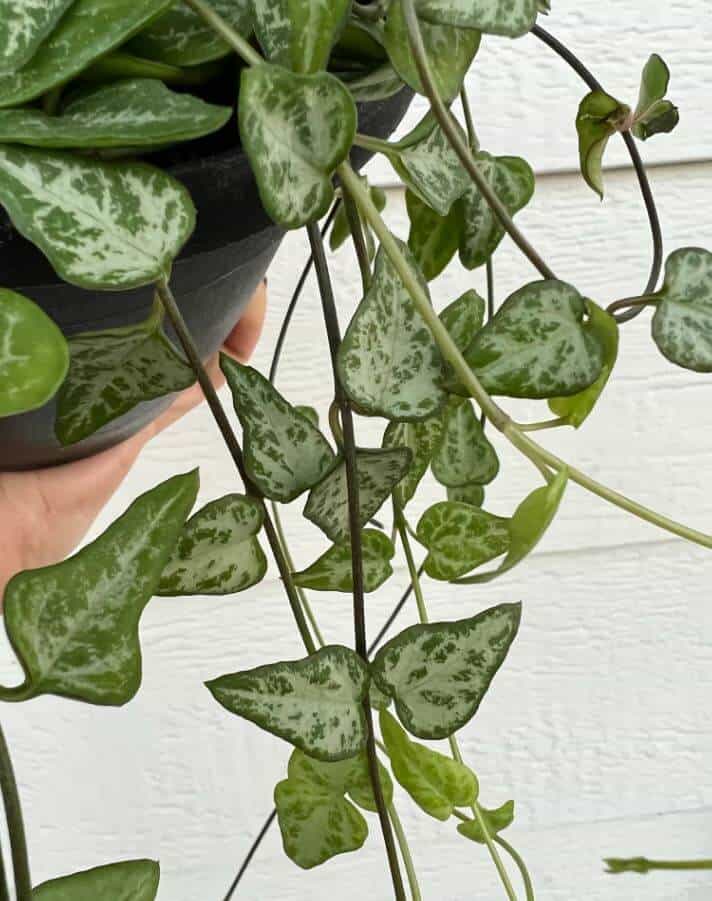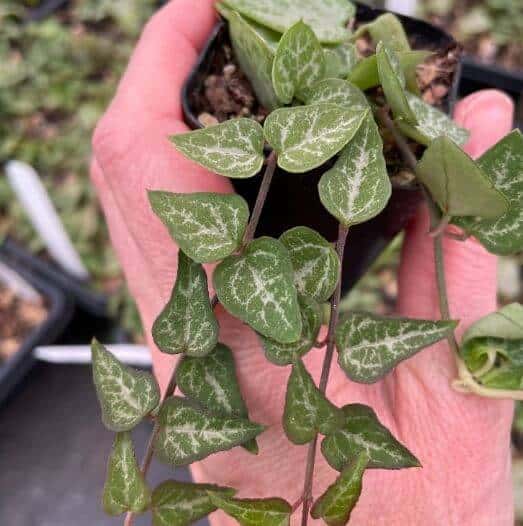Last Updated on February 27, 2023 by a Friendly Gardener
Botanically known as the Ceropegia woodii ‘String of Arrows’, this lovely vining succulent boasts grayish-green-hued foliage that resembles hearts on a string. Silvery-whitish veining mottles leaves to create a unique variegation. Vines are long and reddish-brown and make a wonderful showpiece when cascading down from a hanging basket, high shelf, or even a windowsill.
There are various cultivars of the Ceropegia woodii with probably the best known being the ‘String of Hearts’. However, each cultivar can be identified by the color and shape of the foliage. The String of Arrows distinguishes itself by its leaf shape that is a bit sharper almost to the point to appear more like a triangle. It is not as vividly colored as other members of the group, but leaves do tend toward a deep green emerald.
Members of the Apocynaceae family, these vining succulents are native to South Africa, but also common in Asia and Australia. Your String of Arrows can be cultivated outdoors in USDA hardiness zones 9 through 12.
String of Arrows Plant Care

With proper environmental conditions, this is a fast-growing succulent that will flower. It is a good choice for beginner gardeners as it will forgive some neglect.
Soil

The ideal potting mix for this plant is a mix formulated for cacti and succulents. They do enjoy a bit of fertile soil but not too much as they may appear leggy if overfertilized. Good quality potting mix can be used as long as you amend it with perlite or pumice to ensure excellent drainage.
Light
The String of Arrows prefers filtered, dappled light that is generous and bright. Ample indirect bright light will aid in flowering and growth. The String of Arrows will not thrive in low-light environments or the shade.
Water
This is a succulent and although it can tolerate drought, it still likes to be watered a bit more often than other species of succulents. Beware, however, excessive watering can lead to leaf drops and swollen leaves. Allow the growing medium to dry out between waterings, and then water thoroughly. Never leave one of these succulents standing in water as this can be fatal. Drainage is necessary for the health of the plant.
Humidity
The String of Arrows doesn’t particularly enjoy high humidity, especially if the plant has entered dormancy. Normal household levels of humidity should suffice.
Temperature
The String of Arrows does not like extremes. While they can survive temperatures that drop to approximately 20° F., this exposure to cold should be as brief as possible. This succulent will not do well if left for prolonged periods in the cold. The cold can present a real problem if the succulent has not retained sufficient moisture.
They also do not like high temperatures. The String of Arrows likes a warm climate that offers good air circulation in the 60° to 80° F. range.
Feeding

Select a fertilizer that has been specifically formulated for succulents that do not have a high nitrogen content. Nitrogen can cause the plants to become soft. Follow the instructions for the correct amount that needs to be fed.
Pruning
A String of Arrows does not require pruning per se, but you can trim your plant if the length becomes too long for you. Prune just under a node where foliage grows from the stem. This succulent does not have an adverse reaction to pruning, so feel free to trim as much as you like to obtain the length and appearance you want.
Repotting a String of Arrows Plant

If your plant has a great growth habit due to proper care and environmental conditions, it will need to be repotted every other year. This succulent will be fine if a bit root-bound, but when the roots peek out of the drainage holes, it’s best to give your plant a repotting. Ideally repotting should be done in summer. Do take care of the delicate vines. A good choice in a container is a clay or terracotta pot with a good number of drainage holes. Clay or terracotta will aid in wicking away excess moisture.
Overwintering
Your String of Arrows if left in temps lower than 40° F. will die. Soil beds should be left to dry out in winter as your plant will enter dormancy. In the spring begin to water in small amounts.
String of Arrows Propagation

A String of Arrows plant is usually propagated using stem cuttings. It’s enough to take a four-inch stem cutting with at least two nodes. Roots can form either from water propagation, soil layering, or soil planting.
For traditional soil planting, dip your cut end in rooting hormone and then place it in a container with moistened soil.
For soil layering, position your cutting on the soil bed in a way that the nodes touch the soil. In 2 to 8 weeks your cutting should have formed new roots. If you want to speed things along, cover the cutting with plastic and position it in warm bright, indirect light.
For water propagation, use a glass jar filled with water. Remove the foliage from the bottom half of the cutting and place it in the water. Now place the jar in bright indirect sunlight. The water should be changed once every three days.
Pests and Problems
Like all house plants, the String of Arrows is susceptible to pests, particularly aphids, mealybugs, and scales. If you do not intervene, your plant will wilt and may eventually be overrun. Remove pest infestations with Neem oil and insecticidal soap spray. A jet stream of water is ideal when aphids are the problem.
Diseases to be aware of include root rot usually due to overwatering or poor drainage. Fungal infection of mold is not unheard of especially if pests have deposited residue on foliage and stems.
Yellowing leaves are often due to overwatering or when temperatures are too cold. Leaf drop is also a sign of overwatering as well as a lack of adequate sunlight. Curling leaves can indicate insufficient watering and may end up shriveling and drying out.
String of Spades vs. String of Arrows

The String of Spade’s variety resembles the String of Arrows but boasts darker foliage and more contrast with veining that is a pale green. The String of Spades, like the String of Arrows, has a leaf shape that is not truly heart-shaped but appears more like the spades from a deck of cards. Another distinguishing characteristic of the String of Spades is the way leaves sit on the stem. This succulent’s foliage will sit flat against its stem while other cultivars have foliage that curves outward away from the stem. The String of Spades has the same plant care needs as the String of Arrows and other members of this family.


